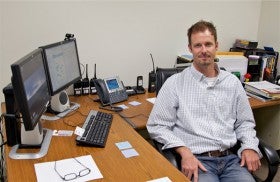Stoecklein on job as new emergency management director
Tim Stoecklein, the new emergency management director at the University of Colorado Colorado Springs, hopes to build on personal and professional experiences to help the campus prepare for an emergency. He will work with other Department of Public Safety staff members to complete tasks ranging from teaching the proper way to operate a fire extinguisher to developing evacuation plans for campus buildings and both developing and testing campus emergency plans.
Stoecklein joined the university in 2007 as associate director of the Campus Recreation Center. Since 2011, he served as part-time assistant director of emergency management.
“Emergency preparedness is really about being aware of your surroundings,” Stoecklein said. “Many of us take the same path to work every single day and never think about what would happen if that stairway was blocked. The time to think about taking a different route is before you need to.”
Among his plans are visits to classrooms this fall to encourage use of the E2Campus emergency notification system and to educate UCCS faculty, staff and students about campus emergency preparation. The emergency messaging system, in addition to sending text messages, also will call many campus telephone numbers, issue email messages, and tap social media to warn of an emergency.
For several years, he has served as a weather spotter for local television stations and the National Weather Service, earning the nickname “Tornado Timmy” for his on-the-ground reports of severe weather. Weather watching is a skill he earned growing up on a western Kansas farm where storms were an important component to his family’s livelihood.
In 2001, Stoecklein was a Fort Hays State University student headed for a weekend camping trip when a tornado ripped through nearby Hoisington, Kan. Instead of a weekend of fishing, Stoecklein and others taking part in his class spent several days helping Hoisington residents recover from an F4 tornado that ripped through the city of 2,700 and nearly wiped it from the map.
“It was an amazing experience,” Stoecklein said. “I realized then that while we can’t control the weather, there is a lot that individuals can do to minimize their risk.”


